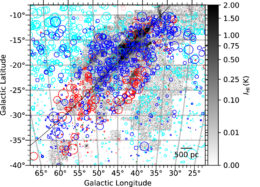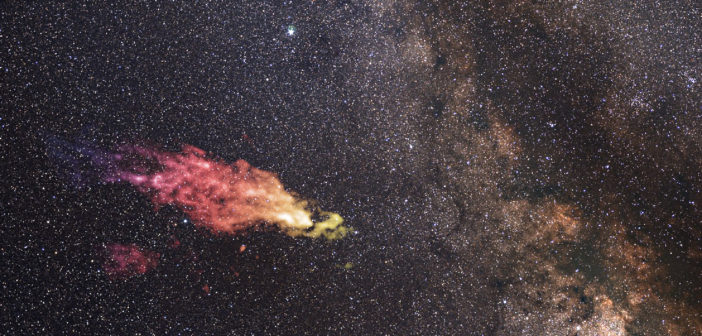High-velocity clouds observed in our galaxy’s halo pose a conundrum: given their tenuous nature and large speeds, why haven’t they been ripped apart? New observations of one such cloud now provide a possible answer.

The Sombrero galaxy, M104, provides an excellent example of a galaxy and its halo — the region that extends above and below the galaxy’s disk. High-velocity clouds have been detected speeding through our own galaxy’s halo. [ESA/C. Carreau]
Plunging Gas
The halo of our galaxy isn’t only host to stars. So-called “high-velocity clouds” — massive collections of gas moving at more than 150,000 mph — zip through the halo, plunging toward and through the galactic disk.
Where does this speedy gas come from? How do the clouds evolve as they pass through the halo? And what protects them from having their gas stripped in the process? There are still many questions about high-velocity clouds that future observations may help us to answer. One cloud in particular makes an ideal target for further exploration: the Smith cloud.
A Useful Target
The Smith cloud consists of at least a million solar masses of gas and lies in the southern sky. It’s shaped as a bright knot with diffuse emission trailing behind it, suggesting this cloud is traveling toward the disk of the galaxy.
From simulations of cloud infall, we expect that any cloud that travels more than ~33,000 light-years through the galactic halo would be stripped of its neutral gas by the hot interstellar medium. Surprisingly, though the Smith cloud has traveled more than that distance, it retains its gas — which means that something must be protecting it. But what?
The relative nearness of the Smith cloud and its large size make it a convenient target to search for the answer. The cloud spans an enormous angular diameter of 10–12 degrees, or about 20 times the diameter of the Moon! By looking through this diffuse cloud at objects behind it, we can learn more about its properties — and in particular, about its magnetic field.
Dragging a Magnetic Field

Rotation measures (RMs) — measurements of how much the cloud caused the background source’s polarization to rotate — for distant radio sources near or behind the Smith cloud. Previous data is shown in cyan and magenta; the authors’ new data is shown in blue and red. Blue and cyan indicate negative RMs (the magnetic field points away from the observer); red and magenta indicate positive RMs (magnetic field points toward the observer). [Betti et al. 2019]
The Smith cloud’s magnetic field, the authors find, appears to be draped over the ionized gas and compressed at the head of the cloud. This geometry is consistent with a picture in which the cloud has swept up the ambient field as it plunges toward the plane of the galaxy, compressing it ahead of the cloud and dragging it along with it.
A Powerful Shield
Can this scenario explain the surprising persistence of the cloud? Perhaps! Past studies have shown that such magnetic field accumulation could be strong enough to shield a cloud’s neutral gas from the hot interstellar medium, protecting it from being stripped as the cloud passes through the halo.
Now that we have detailed observations of the Smith cloud’s magnetic field, careful future modeling can provide tests of whether the field strength is enough to explain how the cloud has survived its travels.
Citation
“Constraining the Magnetic Field of the Smith High-velocity Cloud Using Faraday Rotation,” S. K. Betti et al 2019 ApJ 871 215. doi:10.3847/1538-4357/aaf886


5 Comments
Pingback: AAS Nova – New
Pingback: Mantener entera una nube que viaja a gran velocidad – Observatori Astronòmic
Pingback: Marzo 2019 – Observatori Astronòmic
Pingback: Mantener entera una nube que viaja a gran velocidad « SEDA / LIADA - RedLIADA - Cursos LIADA - Cielo del Mes - Fenómenos Astronómicos - RELEA
Pingback: Mantener entera una nube que viaja a gran velocidad « Sección de Astrofísica de la LIADA